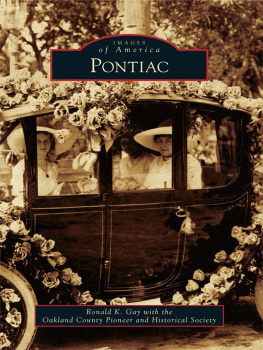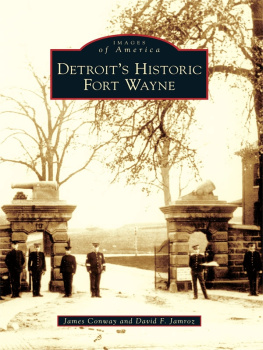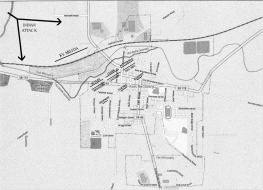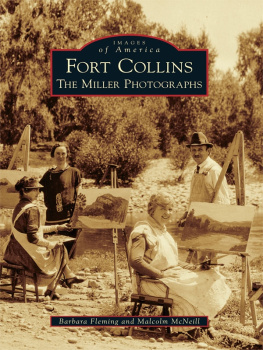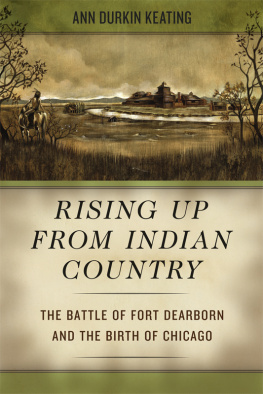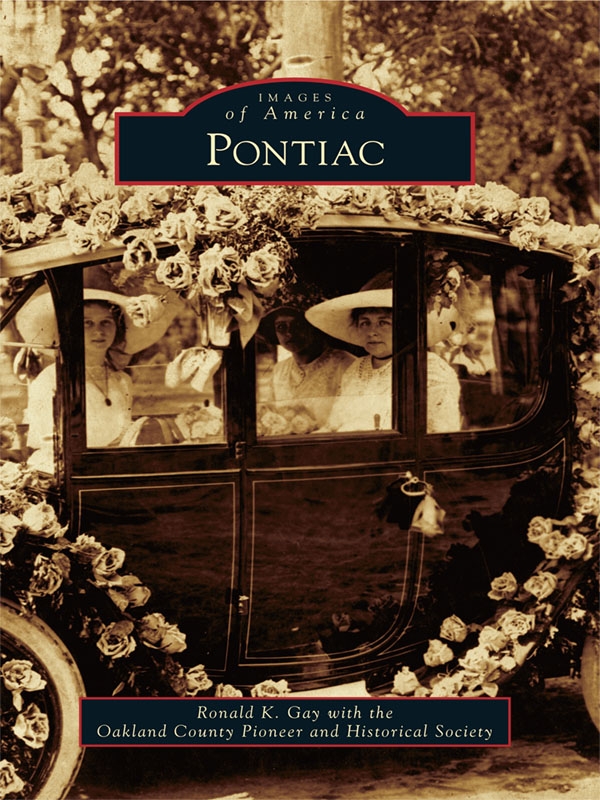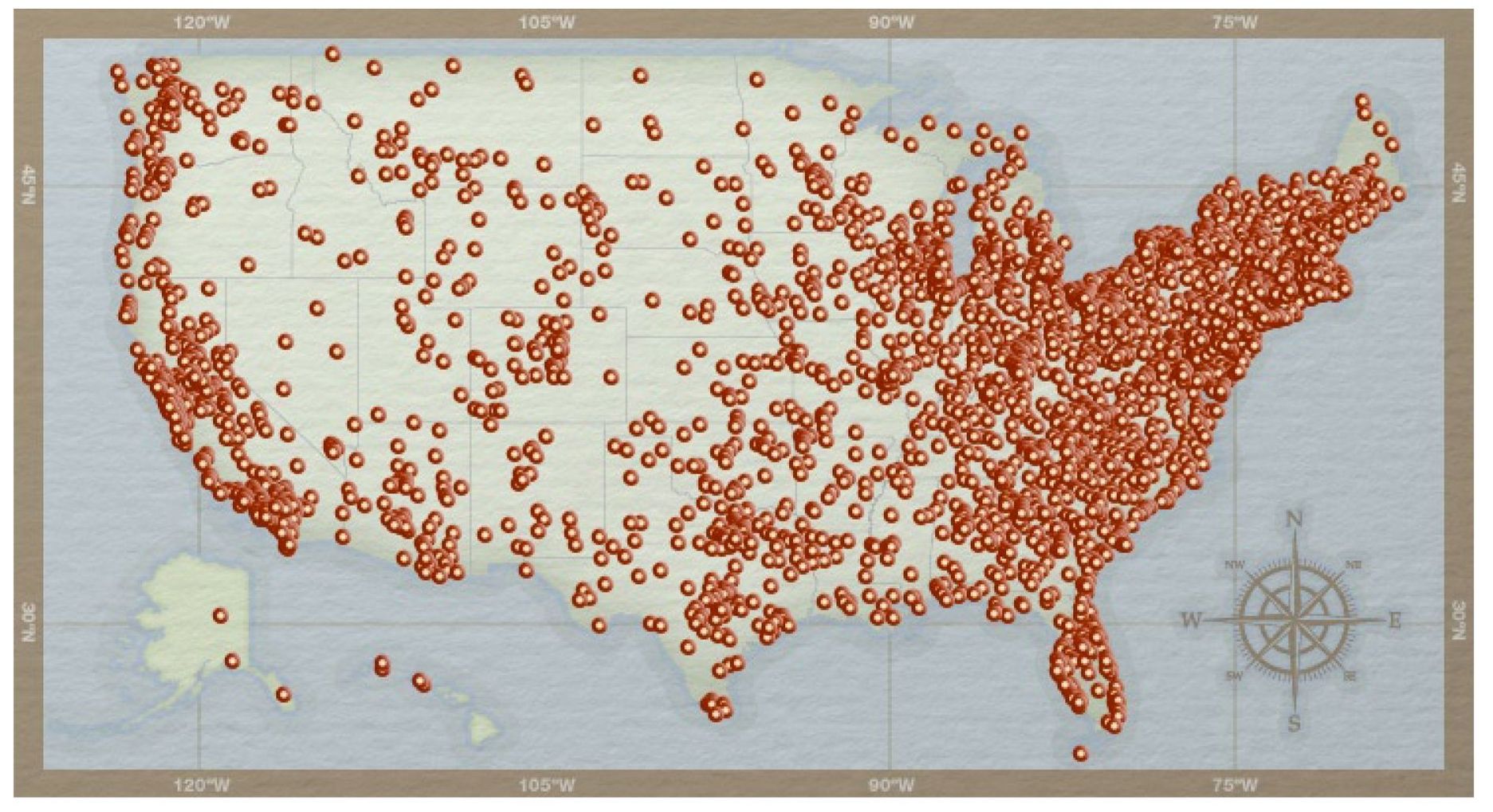ACKNOWLEDGMENTS
This book has been a community effort that utilized public and private historical archives along with many stories shared orally.
I gratefully acknowledge support from the membership of the Oakland Pioneer and Historical Society that made this project possible. Thanks to the board of directors and specifically Mike Willis, Charlie Martinez, Richard Stamps, Mike West, Brian Golden, and Geoff Brieger.
Others who contributed photographs and research aids include: Annalee Kennedy, Linda Porter, the Pontiac Public Library, the City of Pontiac Cemetery, Oakland County International Airport, Oakland County, the Oakland Press , the Salvation Army Central Territory Museum, Cora Bradshaw, Rodney Gay, Bruce Annett, Tom Shafto and Service Glass, Jim and Jerri Fancher, Rich Sign, Helen Jane Peters, Carmen Martinez, Mark Thomas, Dave and Debbie Parker, Ray Henry, Pontiac Creative Arts Center, Norm Kasavage, Micki King, Geoffrey Holmwood, Joe and Ben Benson and Bensons Building Supply, Fisker Automotive, Jordan Vittitow, SilverStream LLCDishmaster Faucet, Kathryn Smith, Ken and Pat Burch, Carol Craven, and Richard Thibadeau. A special thanks goes to James Fassinger, photographer of www.stillscenes.com , for coming to Pontiac to photograph the old coal dock at Canadian National Railroad.
In various other ways, the following people and organizations have contributed to the making of the book: Anna Wilson, Christo Datini, Maj. Gloria Stepke, Jan Odell, Mona Parlove, Cheri Gay, Edmond Richardson, Terry McCormick, Esmo Woods, Marty Padilla, Maria Dana and the Oakland County Research Library staff, William Art Holdsworth and the Oakland County Facilities Management staff, Michelle Stover and the Oakland County International Airport staff, J. David VanderVeen, Glenn Gilbert, Tim Thompson, Guy Duffield, Martha Martinez, Earnest Cleary, Arthur Fowlkes, John Kyros, Elizabeth Clemens, Ashley Koebel, Pablo Cruz, Ken Martin, Len Stesney and Canadian National Railroad, Lisha Fisher, Joe Alessi and Mount Hope Cemetery, Nick Cocciolone, Esther and Lisa Johnson, Wayne Clack, Jeff Lloyd, Robert Oliver, Rod Wilson, Dave Walls, and Fran Anderson.
Special thanks goes to Nancy Thompson, Oakland County Economic Development and Community Affairs, and Ray Henry for their generous assistance.
I looked very hard to find a photograph of Dr. Harold Furlong, a World War I Medal of Honor recipient from Pontiac. With help from Annalee Kennedy, a long search uncovered a picture at Michigans Own Military and Space Museum, a little known treasure. Thank you Stan Bozich for your support.
The Oakland County Pioneer and Historical Society is abbreviated in courtesy lines as OCPHS; Wayne State University is abbreviated as WSU.
BIBLIOGRAPHY
Allerton, Gloria, and Richard Allerton. The Re-Birth of Pontiac . Pontiac, MI: self-published, 1986.
Annett, Bruce J. Jr. Asylum: Pontiacs Grand Monument from the Gilded Age . Pontiac, MI: Oakland County Pioneer and Historical Society.
Automobile Quarterly Magazine . GM: The First 75 Years of Transportation Products. Detroit: General Motors Corporation, 1983.
Brieger, Gottfried. Pontiac, Michigan: A Postcard Album . Chicago: Arcadia Publishing, 2000.
Everts, L. H. and Company. The History of Oakland County, Michigan 18171877 . Philadelphia: self-published, 1877.
Gavrilovich, Peter, and Bill McGraw. The Detroit Almanac . Detroit: Detroit Free Press , 2001.
Green, Mary, and Irma Johnson. Three Feathers, The Story of Pontiac . Chicago: Follett Publishing Company, 1960.
Gunnell, John. GMC The First 100 Years . Iola, WI: Krause Publications, 2002.
Hagman, Arthur A., ed. Oakland County Book of History . Pontiac, MI: Oakland County, 1970.
McAlester, Virginia, and Lee McAlester. A Field Guide to American Houses . New York: Alfred A. Knopf, 1984.
Oakland County. Out of Small Beginnings . Pontiac, MI: self-published, 1976.
Pontiac High School. Quiver, 1942 . Pontiac, MI: self-published, 1942.
. Quiver, 1957 . Pontiac, MI: self-published, 1957.
Shcramm, Jack E., William H. Henning, and Richard R. Andrews. When Eastern Michigan Rode the Rails . Glendale, CA: Interurban Press, 1984.
Woods, Esmo. Pontiac The Making of a U.S. Automobile Capital 18181950 . Pontiac, MI: self-published, 1991.
Various newspaper clippings from the local Pontiac newspapers, including the Pontiac Press with articles by Joe Haas.
ABOUT THE ORGANIZATION
The title of founder and champion of the Oakland County Pioneer and Historical Society belongs to the Honorable Thomas J. Drake. On February 22, 1860, he addressed in Pontiac an audience of pioneer families on the early history of Oakland County. Having been a member of the Michigan Territorial Council as well as serving as senator, newspaper publisher, and highly respected attorney, Drake had the credentials for the topic. Further consideration for such an organization, however, was delayed by the Civil War.
It was not until early 1874 that a group of supporters, headed by Drake, voted to resolve themselves into a body known as the Pioneer Society of Oakland County. Initial members of the society were required to be residents of the county prior to 1840. As time passed, this rule severely restricted eligibility, so membership was expanded to descendants of pioneers and other residents interested in the areas history. The organizations name was also changed to the Oakland County Pioneer and Historical Society. The society and its collections flourished. Members donated all sorts of objects or relics, as the early settlers called them. These artifacts were stored in the old Oakland County Courthouse in downtown Pontiac as well as in the adjacent office buildings.
Storage space reached a crisis stage during World War II. Fortunately the granddaughter of Moses Wisner, the 12th governor of Michigan and a Civil War colonel, offered to sell the residue of her grandfathers estate in Pontiac to the society. Raising funds became the next order of business. This was accomplished by the creation of the Oakland County Pioneer and Veterans Historical Foundation, a nonprofit corporation. In the autumn of 1945, the society moved its collections into the Wisner mansion. In 1962, the Veterans Historical Foundation and the County Historical Society merged, keeping the Oakland County Pioneer and Historical Society name.
Today the society hosts several main attractions: the Governor Wisner mansion and its ancillaries, the Drayton Plains one-room schoolhouse, the research library and archives, and the pioneer museum. The homestead is called Pine Grove, so named by Moses Wisner. For tours or library visits call (248) 338-6732 or e-mail office@ocphs.org.
Charles Martinez
Find more books like this at
www.imagesofamerica.com
Search for your hometown history, your old
stomping grounds, and even your favorite sports team.
One
OUT OF DETROIT
Long before the village of Pontiac was born, the British, French, and the new Americans clashed over the right to lay claim to the densely forested lake lands of Lower Michiganthe Northwest Territory of the day. The Ottawa, Ojibwa, and Potawatomi peoples had been fishing, hunting, and gathering here for ages. The city was named for a great Ottawa warrior, Pontiac. He was the most celebrated Native American of his time in this part of the country. He had led a Native American uprising against the British in 1763, becoming immortalized. At one time not too long ago, Chief Pontiacs picture hung in every public school here.

